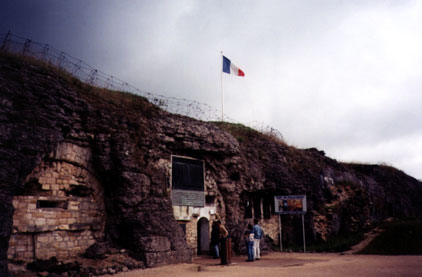|
|
 |
|
|
 |
February 26, 2001
Gallery
Graphic evidence of dysfunction. A slide show of my life.
Digital Art
Proof that I'll never be a professional digital artist no matter what tools you give me.

July 17, 2000, near Verdun, France—World War I soldiers entering Fort de Douaumont might as well have had "it sucks to be you" stamped on their foreheads. The entrance, seen here, was a portal to a life of hell-hole living.
Notes from the July 2000 News Archive:
Fort Douaumont, the largest of the 38 forts which France built to protect its borders after its defeat in the Franco-Prussian War of 1870, took 28 years to build and was completed in 1913. It is almost entirely underground and has several kilometers of tunnels.
In the 1916 Battle of Verdun, Douaumont was hit daily by 800 to 1400 German shells, but only the more powerful 400mm "Big Bertha"-type cannons could pierce the walls. Most of the men inside the fort went deaf from the continual barrage, and given the demonstration our tour guide provided, it's not hard to understand why. She dropped a 50 kg weight onto the now-cement floor (after warning the group, of course) and the sound blasted through the tunnels like an explosion in an echo chamber. She then said that the shells landing on the fort were typically 100 kg and made noise 20 times louder.
During the war, the fort was captured by the Germans then recaptured by the French. As Douaumont is the highest point in the area, it provided a good support position for armies, even if the fort itself was of limited defensive or attacking usefulness. Since both the Germans and French had cannons which could penetrate the fort, there are memorials now to the soldiers who died inside when shells came. The largest of these is German, where on May 8, 1916 an explosion occurred in the grenade depot setting afire a nearby depot containing flame-throwers. Of the 800 to 900 who died, 679 were buried underground behind a wall in the fort.
The living conditions of the fort were awful. The temperature was 50 degrees Fahrenheit inside, water dripped from the ceiling and walls, and the floors were mud. Lighting, which was provided by candles and oil lamps, had the tendency to go out due to lack of oxygen. The fort was ventilated by hand-operated machines. There were no lavatories in the fort in 1916, so you can imagine the stench. Soldiers slept on wooden boards without blankets, mattresses or pillows.
Unable to change their uniforms for days on end, soldiers had a problem with lice and fleas. The fort had a special disinfectant room where the clothes were disinfected by steam and lime, but as the brochure on the fort helpfully points out "this was insufficient to kill all the eggs, and they continued to breed."
In conclusion, it would have made a poor summer home.
Unless otherwise noted this web site and its content, including all graphics, text, audio, and video, are
© 1997-2001 by Ty Davison. All rights reserved.